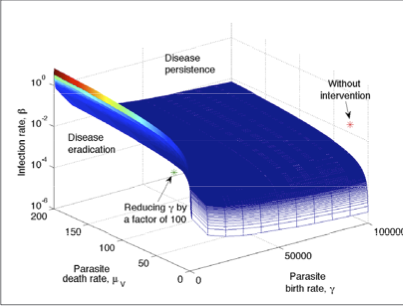Guinea Worm Disease is a parasitic disease, spread via drinking water, that has been with us since antiquity. (It is mentioned in the Bible, and Egyptian mummies suffered from it.) Essentially, the parasite attaches itself to a water flea, you drink the flea, and your stomach acid dissolves the flea leaving the parasite free to invade your body. Because of gravity, it usually makes its way to the foot, where it lives for an entire year.
After a year, your foot is burning and itching, so you put it in water. And if your village only has one source of water, then that source often ends up being the drinking water. At this point, the fully grown worm bursts out of your foot, spraying forth 100,000 parasites and hence restarting the process.
Unfortunately, there is no drug to treat Guinea Worm Disease, and there is no vaccine either. Miraculously, however, Guinea Worm Disease is about to be eradicated, making it the first parasitic disease to be eradicated and the first to be eradicated without biomedical interventions. This is largely thanks to the efforts of former President Jimmy Carter. So how can one eradicate a disease without a drug, vaccine or immunity?
Using a mathematical model, we can quantify the major factors that we can control: education (reducing the parasite birth rate $\gamma$), filtration (reducing the transmission $\beta$) and chlorination (increasing the parasite death rate $\mu_V$). The basic reproductive ratio $R_0$ represents the mean number of individuals infected by each infected individual. Hence, eradication starts under the threshold $R_0 = 1$.
The figure represents the level surface $R_0(\gamma,\beta,\mu_V)=1$. If you are above the surface, then $R_0$ is greater than 1 and the disease will persist. If you are below the surface, then $R_0$ is less than 1 and the disease will be eradicated.
Increasing the parasite death rate involves moving along the $\mu_V$ axis to the rear left. But the level surface is very shallow, so you need to move a long way to the back corner to get under the surface. Reducing transmissibility involves moving down the $\beta$-axis. But this is on a log scale, so that takes much longer than it first appears. However, see how steep the surface is for small $\gamma$? This makes it very easy to move under it by a small change in $\gamma$. This suggests that eradication should occur if we stick to one strategy: reducing the parasite birth rate.
Encouraging people not to put their infected limbs in the drinking water means that each time a worm doesn’t burst into the water and 100,000 parasites aren’t released. What this means is that, in the final push to eradication, we should concentrate our efforts on reaching remote communities, informing them about the specifics of Guinea Worm Disease and its transmission cycle. Of course, a combination of all three factors will help. But it’s education that holds the key to removing this ancient scourge and points the way forward to controlling or eradicating other diseases without waiting for someone to develop a vaccine. If we can harness the power of education, we can change the world.
Robert Smith?, Ottawa
